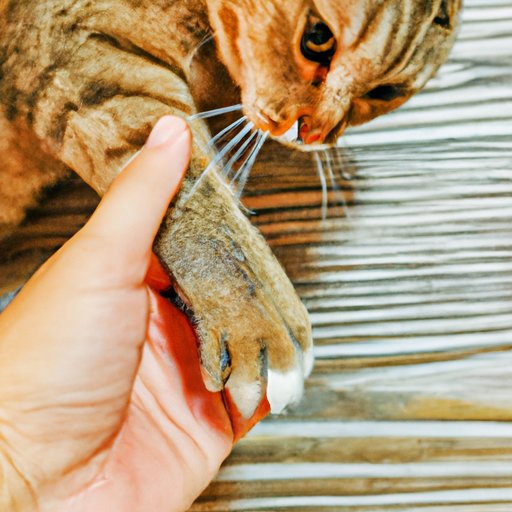
How to Stop Your Cat from Scratching the Couch: Tips and Tricks
There’s nothing worse than coming home to find your couch destroyed by your beloved feline friend. But before you get frustrated, it’s important to understand why cats scratch in the first place. Scratching is a natural behavior for cats, as it helps them sharpen their claws, stretch their muscles, and mark their territory. However, it’s important to provide alternatives to the couch so that your cat doesn’t continue to damage your furniture.
In this article, we’ll provide you with some tips and tricks to train your cat to stop scratching the couch and start using appropriate alternatives.
Provide a Variety of Scratching Alternatives
One important aspect of training your cat to stop scratching the couch is to provide a variety of scratching alternatives in different areas of your home. This will increase the likelihood that your cat will use them instead of the couch.
When choosing scratching posts, consider different types such as vertical, horizontal, sisal, carpet, or cardboard. Experiment with different textures and shapes to find what your cat prefers.
Additionally, you can use positive reinforcement to encourage your cat to use the scratching posts. Place the post in an area where your cat typically scratches, sprinkle some catnip on it or put some treats on and around the post. When your cat uses the post, offer them praise and affection. Over time, they will learn that scratching the post leads to good things.
Use a Scratching Deterrent Spray
If your cat persistently scratches the couch despite the provided alternatives, using a scratching deterrent spray can be helpful in discouraging them. These sprays work by deterring cats from scratching surfaces by providing them with an unpleasant taste or smell.
When using a scratching deterrent spray, choose a product that is safe for your cat and follows the product’s instructions on how to apply it. However, if you prefer using natural alternatives, homemade deterrent sprays can be created using water, vinegar, citrus, and essential oils. Use a cotton swab to apply the spray on your couch, preferably in an inconspicuous area to test for stains or discoloration and avoid spraying near your cat’s food or water dish.
Provide Positive Reinforcement
Positive reinforcement is a crucial aspect of training your cat to stop scratching the couch. Reward your cat every time they use an appropriate scratching post. You can use treats, affection, or a favorite toy. The more immediate and specific the reward, the better. Rewarding your cat right after they use the scratching post will reinforce the behavior.
It’s important to note that punishment should never be used to train your cat. This includes yelling, spraying water, or physical punishments. These actions will only reinforce fear and anxiety in your cat, making them less likely to engage in desirable behaviors.
Cover Up the Couch
Covering the couch can also be helpful, especially if your cat keeps returning to the same spot. This can help the cat understand that the couch isn’t a good place to scratch. Consider coverings that have an unfamiliar texture or a loud crinkle to deter your cat. You can use materials like plastic sheeting, aluminum foil, or purchasing commercially available products from a pet store.
When using a covering, always supervise your cat to make sure they aren’t chewing or swallowing anything hazardous, and to ensure that your cat still has access to its litter box and food and water bowls. You can gradually remove the covering as your cat begins to use the scratching post instead of the couch.
Trim Your Cat’s Nails
Regular nail trimming is an essential aspect of cat care. Trimming your cat’s nails will not only protect your couch, but it will also prevent your cat’s nails from becoming ingrown or causing discomfort. Start by getting your cat used to having its paws handled, then provide treats while cutting its nails. Only trim the sharp tip of the nail. If you’re not comfortable trimming your cat’s nails, a vet or a groomer can help you.
In addition to nail trimming, scratching pads and nail caps can also help hinder the impact of your cat’s claws on your couch. They’re available in pet stores and can be an excellent alternative if your cat still persists in scratching your furniture.
Seek Professional Help
If none of the above solutions are successful, it might be a good idea to seek professional help. A vet or a cat behaviorist will be able to offer personalized advice to deal with your cat’s specific behavior.
It’s important to be patient and consistent. Training your cat is not an overnight process and may take several weeks or months to see positive results. Remember to persist, and your cat can learn to stop scratching your couch over time.
Conclusion
Cats scratch, and that’s normal. But when it comes to our furniture, it can be a frustrating problem that is a risk to the safety of our cats. By providing a variety of scratching alternatives, using scratches deterrent spray, giving positive rewards, covering up the couch, and trimming your cat’s nails, you can train your cat to use appropriate alternatives, such as a scratching post or pad. If all else fails, seeking help from a behaviorist or a veterinarian might be necessary. With the right patience and consistency, you can train your cat to stop scratching your couch and enjoy a happy life together.





